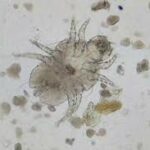What Are House Dust Mites?
Dust mites are in your home and cause allergic reactions. They belong to the family of eight-legged creatures called arachnids. This family also includes spiders, chiggers and ticks. Dust mites are hardy creatures that multiply easily in warm, humid places. They prefer temperatures at or above 70°F with a relative humidity of 55-80 percent and die when the humidity falls below 45 percent. Dust mites are rarely found in dry climates.
As many as 10 percent of the general population and 90 percent of people with allergies and asthma are sensitive to dust mites. Recent studies in the United States suggest that at least 45 percent of young people with asthma are allergic to dust mites.

People who are allergic to dust mites react to proteins in their decomposition and feces. These particles are found in the highest concentrations in pillows, mattresses, carpets, rugs, and upholstery. They are so very light they can float in the air for hours. When disturbed by: air flow, vacuums, foot traffic, ruffled bedding, pets, they settle out into the air again.
Dust mite-allergic people who inhale these particles experience more frequent allergic symptoms. In fact, a dust mite allergic patient who sleeps for 8 hours every night spends one third of his or her life with their nose in direct contact with a pillow loaded with dust mite particles!
There may be many as 19,000 dust mites in one gram of dust, but usually between 100 to 500 mites live in each gram. (A gram is about the weight of a paper clip.) Each mite produces about 10-20 waste particles per day and lives for 30 days. Egg-laying females can add 25-30 new mites to the population during their lifetime. Dusty mite critters eat particles of skin and dander, so they thrive in places where there are people. Dust mites don’t bite, cannot spread diseases and usually do not live on people. They are harmful only to people who become allergic to them. While usual household cleaning and insecticides have no effect on dust mites, there are ways to reduce exposure to dust mites in the home. Make it Sparkle.

